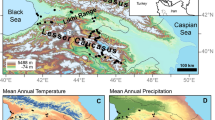Abstract
Due to regional glacio-isostatic uplift of land during the Holocene period, a large number of penguin populations from several rookeries began to nest on the newly formed beaches and emerged rocks, leaving previously colonized higher cliffs. Chronology and extent of raised beaches, lichenometric age estimation of Usnea antarctica and radiocarbon-dating of guano and subfossil penguin bones in the abandoned nesting sites suggest the progress of the downward movement of many rookeries about 2500 years ago, accelerated during the last millennium, when wide bands of 4 to 6 m raised beaches were formed. Patterns of relic ornithogenic soil formation in the abandoned rookeries (focussed on leaching, erosion processes and humus horizon creation), as well as the succession of vegetation in the age sequence of abandoned nesting sites, were investigated in detail at Stranger Point, King George Island. The chemical composition of Deschampsia antarctica growing in the area of active, abandoned rookeries and in control sites provides direct and indirect evidence of current and past ornithogenic manuring on nutrition of vegetation.
Similar content being viewed by others
Author information
Authors and Affiliations
Additional information
Received: 10 January 1996 / Accepted: 8 September 1996
Rights and permissions
About this article
Cite this article
Tatur, A., Myrcha, A. & Niegodzisz, J. Formation of abandoned penguin rookery ecosystems in the maritime Antarctic. Polar Biol 17, 405–417 (1997). https://doi.org/10.1007/s003000050135
Issue Date:
DOI: https://doi.org/10.1007/s003000050135




